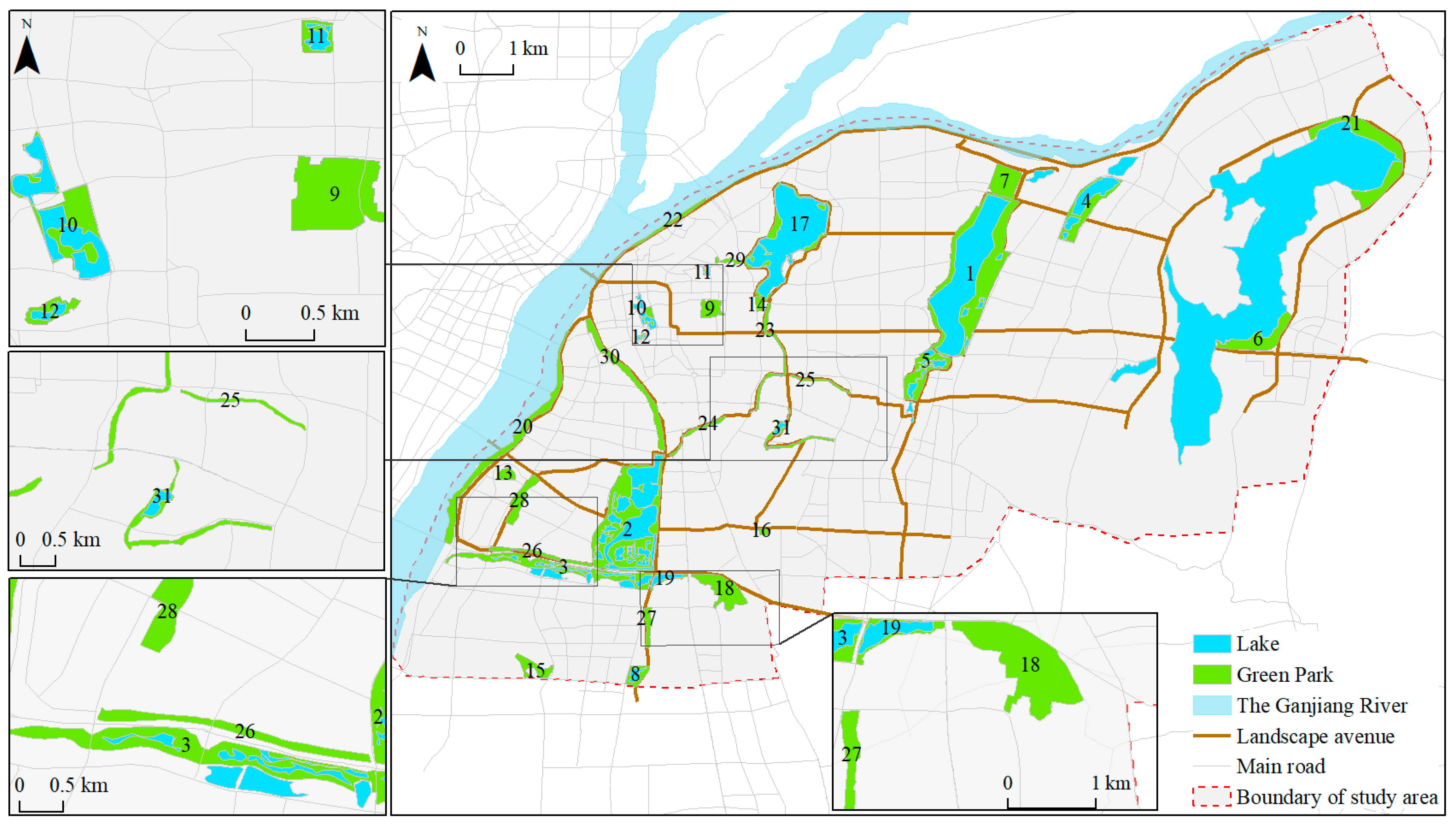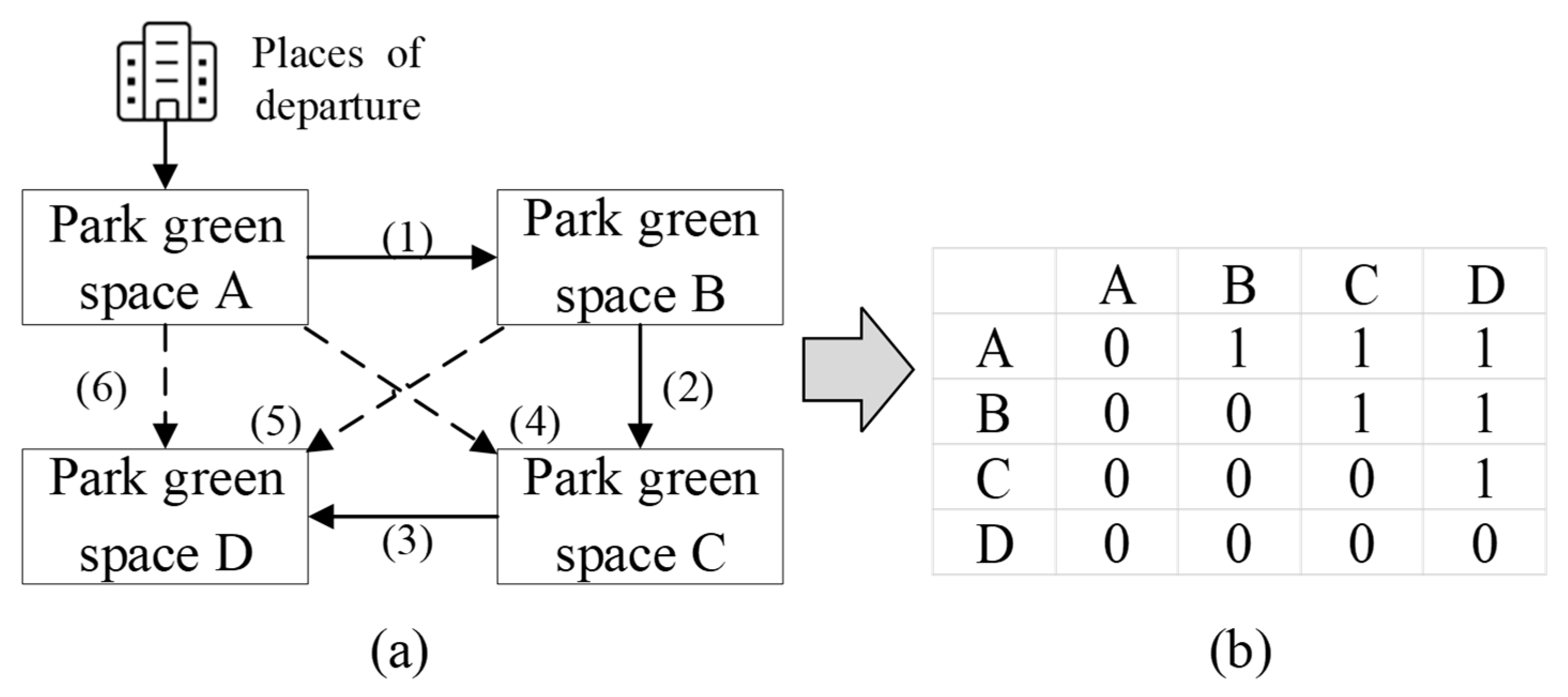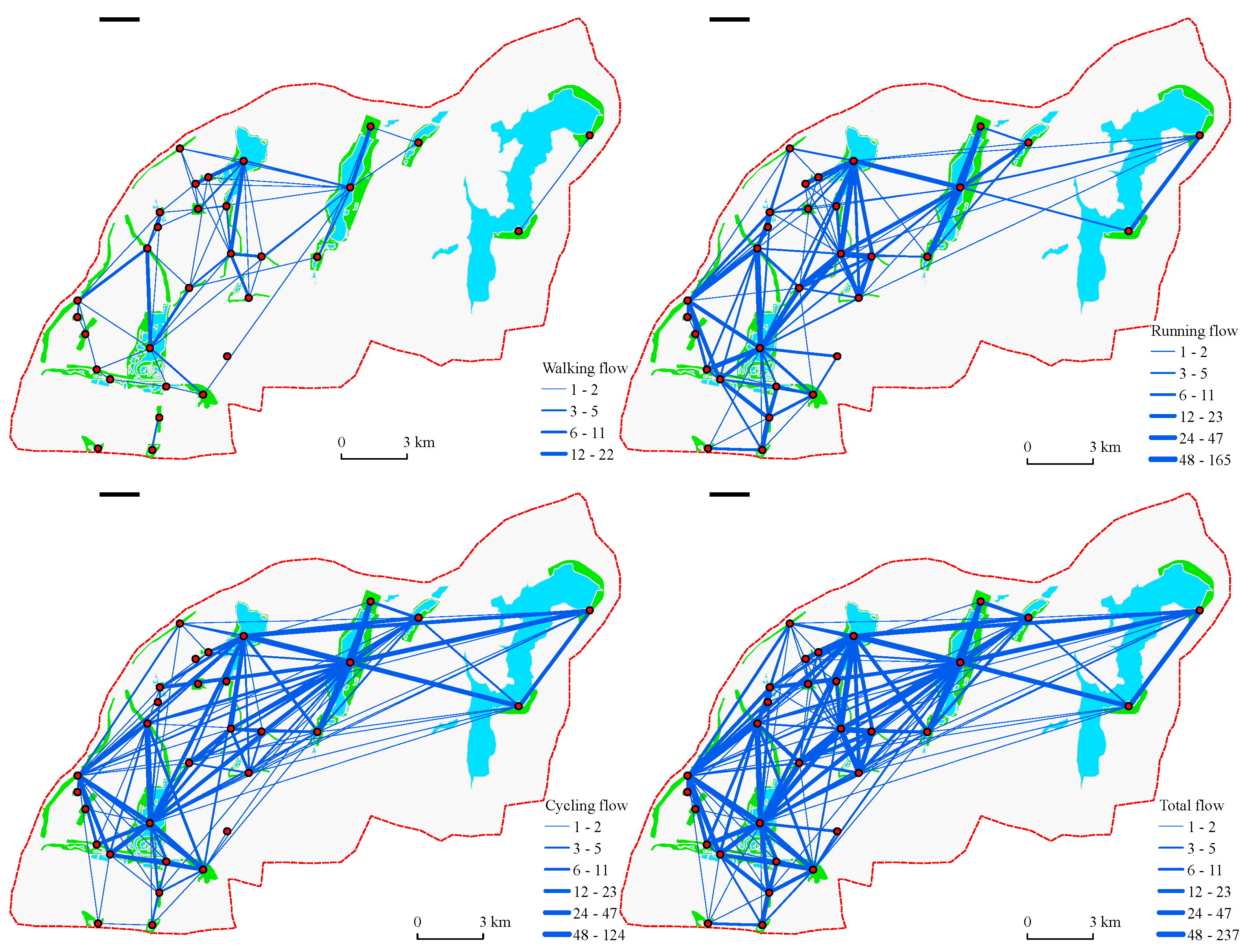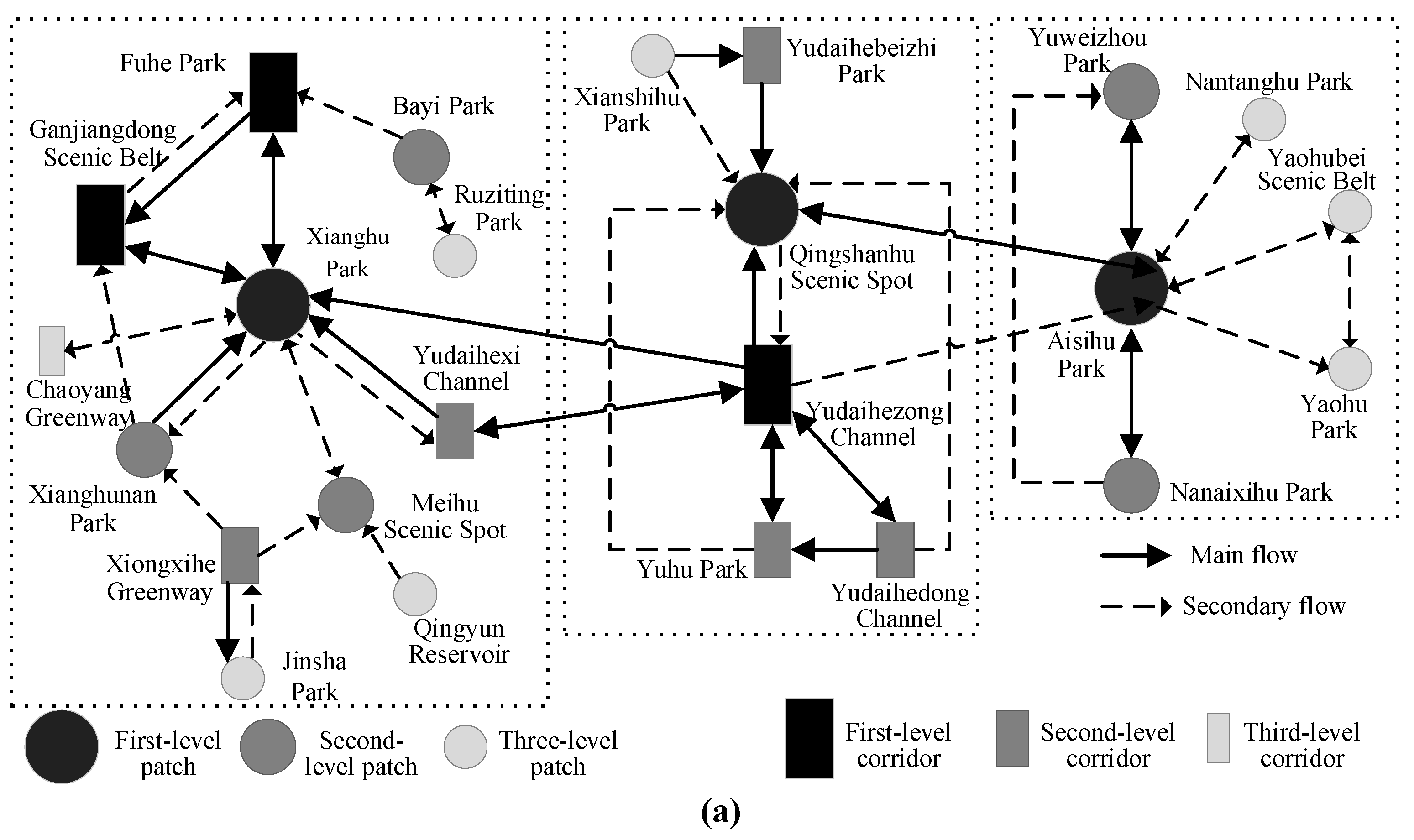The Flow of Green Exercise, Its Characteristics, Mechanism, and Pattern in Urban Green Space Networks: A Case Study of Nangchang, China
Abstract
1. Introduction
2. Study Area, Materials and Methods
2.1. Study Area
2.2. Data
2.3. Methods
2.3.1. Method for Evaluating Nodes and Network Characteristics
2.3.2. The Mechanism behind the Flow Based on the Gravity Model
2.3.3. Measuring the Spatial Spillover Effect of Green Space Networks
3. Results
3.1. Analysis of Node Characteristics
3.1.1. Analysis of Node Centrality in the Total Flow
3.1.2. The Effect of the Indirect Flow on the Centrality of the Nodes
3.2. Flow Network Analysis
3.2.1. The Flow Network under Different Types of Exercise
3.2.2. The Flow Network under Different Flow Volumes
3.2.3. The Flow Network under Different Distances
3.2.4. The Status of First-Level Patches in the Flow Network
3.3. Flow Mechanism, Pattern, and Spatial Spillover Effect
3.3.1. Analysis of the Mechanism behind the Flow of Green Exercise
3.3.2. Analysis of Flow Patterns
3.3.3. The Spillover Effect of the Urban Green Space Network
4. Discussion
4.1. The Optimization Path for the Urban Green Space Network
4.2. Limitations and Further Research
5. Conclusions
Author Contributions
Funding
Data Availability Statement
Acknowledgments
Conflicts of Interest
References
- Dieterich, A.V.; Müller, A.M.; Akksilp, K.; Sarin, K.C.; Dabak, S.V.; Rouyard, T. Reducing sedentary behaviour and physical inactivity in the workplace: Protocol for a review of systematic reviews. BMJ Open Sport Exerc. Med. 2020, 6, e000909. [Google Scholar] [CrossRef] [PubMed]
- Jiang, X.X.; Hardy, L.L.; Ding, D.; Baur, L.A.; Shi, H.J. Recreational Screen-Time Among Chinese Adolescents: A Cross-Sectional Study. J. Epidemiol. 2014, 24, 397–403. [Google Scholar] [CrossRef]
- Guthold, R.; Stevens, G.A.; Riley, L.M.; Bull, F.C. Worldwide trends in insufficient physical activity from 2001 to 2016: A pooled analysis of 358 population-based surveys with 1.9 million participants. Lancet Glob. Health 2018, 6, E1077–E1086. [Google Scholar] [CrossRef] [PubMed]
- van der Ploeg, H.P.; Bull, F.C. Invest in physical activity to protect and promote health: The 2020 WHO guidelines on physical activity and sedentary behaviour. Int. J. Behav. Nutr. Phys. Act. 2020, 17, 145. [Google Scholar] [CrossRef]
- Veerkamp, C.J.; Schipper, A.M.; Hedlund, K.; Lazarova, T.; Nordin, A.; Hanson, H.I. A review of studies assessing ecosystem services provided by urban green and blue infrastructure. Ecosyst. Serv. 2021, 52, 101367. [Google Scholar] [CrossRef]
- Fang, C.Y.; Cai, Z.R.; Devlin, A.T.; Yan, X.; Chen, H.; Zeng, X.W.; Xia, Y.; Zhang, Q. Ecosystem services in conservation planning: Assessing compatible vs. incompatible conservation. J. Environ. Manag. 2022, 312, 114906. [Google Scholar] [CrossRef]
- Dai, X.; Wang, L.; Tao, M.; Huang, C.; Sun, J.; Wang, S. Assessing the ecological balance between supply and demand of blue-green infrastructure. J. Environ. Manag. 2021, 288, 112454. [Google Scholar] [CrossRef] [PubMed]
- Shanahan, D.F.; Franco, L.; Lin, B.B.; Gaston, K.J.; Fuller, R.A. The Benefits of Natural Environments for Physical Activity. Sport. Med. 2016, 46, 989–995. [Google Scholar] [CrossRef]
- Flowers, E.P.; Freeman, P.; Gladwell, V.F. Enhancing the acute psychological benefits of green exercise: An investigation of expectancy effects. Psychol. Sport Exerc. 2018, 39, 213–221. [Google Scholar] [CrossRef]
- Lahart, I.; Darcy, P.; Gidlow, C.; Calogiuri, G. The Effects of Green Exercise on Physical and Mental Wellbeing: A Systematic Review. Int. J. Environ. Res. Public Health 2019, 16, 1352. [Google Scholar] [CrossRef]
- Brito, H.; Brymer, E.; Araujo, D. An ecological dynamics perspective on designing urban nature environments for wellbeing and health-enhancing physical activity. Front. Public Health 2022, 10, 7208. [Google Scholar] [CrossRef] [PubMed]
- Tan, C.L.Y.; Chang, C.C.; Nghiem, L.P.; Zhang, Y.C.; Oh, R.R.Y.; Shanahan, D.F.; Lin, B.B.; Gaston, K.J.; Fuller, R.A.; Carrasco, L.R. The right mix: Residential urban green-blue space combinations are correlated with physical exercise in a tropical city-state. Urban For. Urban Green. 2021, 57, 126947. [Google Scholar] [CrossRef]
- Petrunoff, N.A.; Edney, S.; Yi, N.X.; Dickens, B.L.; Joel, K.R.; Xin, W.N.; Sia, A.; Leong, D.; van Dam, R.M.; Cook, A.R.; et al. Associations of park features with park use and park-based physical activity in an urban environment in Asia: A cross-sectional study. Health Place 2022, 75, 102790. [Google Scholar] [CrossRef] [PubMed]
- Aliyas, Z.; Ujang, N.; Zandieh, M. Park Characteristics in Relation to Exercise and Recreational Walking. Environ. Justice 2019, 12, 218–225. [Google Scholar] [CrossRef]
- Stewart, O.T.; Moudon, A.V.; Littman, A.J.; Seto, E.; Saelens, B.E. Why neighborhood park proximity is not associated with total physical activity. Health Place 2018, 52, 163–169. [Google Scholar] [CrossRef]
- Zhai, Y.; Li, D.; Wu, C.; Wu, H. Urban park facility use and intensity of seniors’ physical activity—An examination combining accelerometer and GPS tracking. Landsc. Urban Plan. 2021, 205, 103950. [Google Scholar] [CrossRef]
- Liu, Q.; Ullah, H.; Wan, W.G.; Peng, Z.Y.; Hou, L.; Qu, T.; Haidery, S.A. Analysis of Green Spaces by Utilizing Big Data to Support Smart Cities and Environment: A Case Study About the City Center of Shanghai. Isprs Int. J. Geo-Inf. 2020, 9, 360. [Google Scholar] [CrossRef]
- Li, C.; Zhao, J.; Yin, J.; Chi, G. Park access affects physical activity: New evidence from geolocated Twitter data analysis. J. Urban Des. 2022, 27, 1–20. [Google Scholar] [CrossRef]
- Zhang, S.M.; Zhang, W.S.; Wang, Y.; Zhao, X.Y.; Song, P.H.; Tian, G.H.; Mayer, A.L. Comparing Human Activity Density and Green Space Supply Using the Baidu Heat Map in Zhengzhou, China. Sustainability 2020, 12, 7075. [Google Scholar] [CrossRef]
- He, B.; Hu, J.X.; Liu, K.; Xue, J.Z.; Ning, L.; Fan, J.P. Exploring Park Visit Variability Using Cell Phone Data in Shenzhen, China. Remote Sens. 2022, 14, 499. [Google Scholar] [CrossRef]
- Liu, Y.; Hu, J.; Yang, W.; Luo, C. Effects of urban park environment on recreational jogging activity based on trajectory data: A case of Chongqing, China. Urban For. Urban Green. 2022, 67, 127443. [Google Scholar] [CrossRef]
- Park, Y.; Lee, S.; Park, S. Differences in Park Walking, Comparing the Physically Inactive and Active Groups: Data from mHealth Monitoring System in Seoul. Int. J. Environ. Res. Public Health 2022, 19, 395. [Google Scholar] [CrossRef] [PubMed]
- Du, J.F.; Yu, M.X.; Cong, Y.G.; Lv, H.Z.; Yuan, Z.Y. Soil Organic Carbon Storage in Urban Green Space and Its Influencing Factors: A Case Study of the 0-20 cm Soil Layer in Guangzhou City. Land 2022, 11, 1484. [Google Scholar] [CrossRef]
- Tian, Y.X.; Ning, H.D.; Ren, H.Q.; Liu, J.J.; Wang, K.; Hong, B. National Fitness Evaluation of Urban Parks in the National Ecological Garden City: A Case Study in Baoji, China. Land 2022, 11, 889. [Google Scholar] [CrossRef]
- Zhu, R.; Janowicz, K.; Mai, G.C. Making direction a first-class citizen of Tobler’s first law of geography. Trans. GIS 2019, 23, 398–416. [Google Scholar] [CrossRef]
- Dolan, R.; Bullock, J.M.; Jones, J.P.G.; Athanasiadis, I.N.; Martinez-Lopez, J.; Willcock, S. The Flows of Nature to People, and of People to Nature: Applying Movement Concepts to Ecosystem Services. Land 2021, 10, 576. [Google Scholar] [CrossRef]
- Tao, H.; Zhou, Q.; Tian, D.; Zhu, L. The Effect of Leisure Involvement on Place Attachment: Flow Experience as Mediating Role. Land 2022, 11, 151. [Google Scholar] [CrossRef]
- The People’s Government of Nanchang Municipality. Nanchang Park System Development Plan (2021–2035). Available online: http://www.nc.gov.cn/ncszf/zxfzgh/202202/e680e6480b7f4c8a93fe095490220215.shtml (accessed on 1 December 2022).
- Wang, F.; Chen, J.; Tong, S.; Zheng, X.; Ji, X. Construction and Optimization of Green Infrastructure Network Based on Space Syntax: A Case Study of Suining County, Jiangsu Province. Sustainability 2022, 14, 7732. [Google Scholar] [CrossRef]
- Huang, B.-X.; Chiou, S.-C.; Li, W.-Y. Landscape Pattern and Ecological Network Structure in Urban Green Space Planning: A Case Study of Fuzhou City. Land 2021, 10, 769. [Google Scholar] [CrossRef]
- Chen, H.; Wang, M.; Zheng, S. Research on the Spatial Network Effect of Urban Tourism Flows from Shanghai Disneyland. Sustainability 2022, 14, 3973. [Google Scholar] [CrossRef]
- Kim, E.-J.; Jo, Y.; Kang, Y. Are Touristic Attractions Well-Connected in an Olympic Host City? A Network Analysis Measurement of Visitor Movement Patterns in Gangneung, South Korea. Sustainability 2018, 10, 3310. [Google Scholar] [CrossRef]
- Wang, Y.; Xi, M.; Chen, H.; Lu, C. Evolution and Driving Mechanism of Tourism Flow Networks in the Yangtze River Delta Urban Agglomeration Based on Social Network Analysis and Geographic Information System: A Double-Network Perspective. Sustainability 2022, 14, 7656. [Google Scholar] [CrossRef]
- Cevik, S. Going Viral: A Gravity Model of Infectious Diseases and Tourism Flows. Open Econ. Rev. 2022, 33, 141–156. [Google Scholar] [CrossRef]
- Zhang, Y.; Jiang, P.; Cui, L.; Yang, Y.; Ma, Z.; Wang, Y.; Miao, D. Study on the spatial variation of China’s territorial ecological space based on the standard deviation ellipse. Front. Environ. Sci. 2022, 10, 982734. [Google Scholar] [CrossRef]
- Yang, Y.; Zhou, Y.; Feng, Z.; Wu, K. Making the Case for Parks: Construction of an Ecological Network of Urban Parks Based on Birds. Land 2022, 11, 1144. [Google Scholar] [CrossRef]
- Huse, B.; Szabo, S.; Deak, B.; Tothmeresz, B. Mapping an ecological network of green habitat patches and their role in maintaining urban biodiversity in and around Debrecen city (Eastern Hungary). Land Use Policy 2016, 57, 574–581. [Google Scholar] [CrossRef]
- Dai, P.C.; Zhang, S.L.; Hou, H.P.; Yang, Y.J.; Liu, R. Valuing sports services in urban parks: A new model based on social network data. Ecosyst. Serv. 2019, 36, 100891. [Google Scholar] [CrossRef]
- Feng, X.H.; Tang, Y.; Bi, M.Y.; Xiao, Z.P.; Zhong, Y.X. Analysis of Urban Resilience in Water Network Cities Based on Scale-Density-Morphology-Function (SDMF) Framework: A Case Study of Nanchang City, China. Land 2022, 11, 898. [Google Scholar] [CrossRef]
- Chen, C.X.; Luo, W.J.; Li, H.W.; Zhang, D.T.; Kang, N.; Yang, X.H.; Xia, Y. Impact of Perception of Green Space for Health Promotion on Willingness to Use Parks and Actual Use among Young Urban Residents. Int. J. Environ. Res. Public Health 2020, 17, 5560. [Google Scholar] [CrossRef]
- Lee, B.B.; Yeon, P.; Park, S. The Factors and Relationships Influencing Forest Hiking Exercise Characteristics after COVID-19 Occurrence: At Seoul Metropolitan Area and in Hikers’ 20s and 30s. Int. J. Environ. Res. Public Health 2022, 19, 6403. [Google Scholar] [CrossRef]
- Astell-Burt, T.; Feng, X.Q. Time for ‘Green’ during COVID-19? Inequities in Green and Blue Space Access, Visitation and Felt Benefits. Int. J. Environ. Res. Public Health 2021, 18, 2757. [Google Scholar] [CrossRef] [PubMed]
- Xiao, X.; Fang, C.; Lin, H.; Chen, J. A framework for quantitative analysis and differentiated marketing of tourism destination image based on visual content of photos. Tour. Manag. 2022, 93, 104585. [Google Scholar] [CrossRef]
- Xiao, X.; Fang, C.; Lin, H. Characterizing Tourism Destination Image Using Photos’ Visual Content. Isprs Int. J. Geo-Inf. 2020, 9, 730. [Google Scholar] [CrossRef]











| Node Type | Specific Name |
|---|---|
| Patch | 1. Aisihu Park, 2. Xianghu Park, 3. Xianghunan Park, 4. Nantanghu Park, 5. Nanaixihu Park, 6. Yaohu Park, 7. Yuweizhou Park, 8. Jinsha Park, 9. People’s Park, 10. Bayi Park, 11. Xianshihu Park, 12. Ruziting Park, 13. Chaoyangzhongyang Park, 14. Qingshanhu Sports Park, 15. Changnan Sports Park, 16. Baojia Sports Park, 17. Qingshanhu Scenic Spot, 18. Meihu Scenic Spot, 19. Qingyun Reservoir |
| Corridor | 20. Ganjiangdong Scenic Belt, 21. Yaohubei Scenic Belt, 22. Ganjiangbei Scenic Belt, 23. Yudaihezong Channel, 24. Yudaihexi Channel, 25. Yudaihedong Channel, 26. Chaoyang Greenway, 27. Xiongxihe Greenway, 28. Taohuahe Park, 29. Yudaihebeizhi Park, 30. Fuhe Park, 31. Yuhu Park |
| Flow Type | Number of Nodes | Number of Paths | Network Density | Network Centrality | Average Flow of a Path | Proportion of the Flow |
|---|---|---|---|---|---|---|
| Walking flow | 29 | 82 | 0.101 | 0.117 | 3.56 | 8.30% |
| Running flow | 31 | 156 | 0.168 | 0.335 | 12.81 | 52.93% |
| Cycling flow | 28 | 193 | 0.255 | 0.227 | 8.37 | 38.77% |
| Total flow | 31 | 267 | 0.287 | 0.214 | 16.13 | 100.00% |
| Flow Volume Threshold | Number of Nodes | Number of Paths | Network Density | Network Centrality | Average Flow of a Path | Proportion of the Flow |
|---|---|---|---|---|---|---|
| ≥3 | 30 | 142 | 0.163 | 0.273 | 24.39 | 97.09% |
| ≥12 | 24 | 53 | 0.092 | 0.355 | 44.06 | 85.99% |
| ≥24 | 16 | 25 | 0.104 | 0.093 | 71.65 | 71.30% |
| ≥48 | 10 | 12 | 0.133 | 0.145 | 114.92 | 52.77% |
| Distance | Number of Nodes | Number of Paths | Network Density | Network Centrality | Average Flow of a Path | Proportion of the Running Flow | Proportion of the Cycling Flow |
|---|---|---|---|---|---|---|---|
| (0, 2] | 26 | 77 | 0.119 | 0.236 | 22.87 | 61.39% | 28.73% |
| (2, 4] | 19 | 27 | 0.079 | 0.098 | 14.11 | 41.21% | 54.86% |
| (4, 6] | 17 | 21 | 0.077 | 0.037 | 7.52 | 39.87% | 55.70% |
| ≥6 | 12 | 17 | 0.129 | 0.246 | 8.53 | 9.66% | 88.97% |
| Patch Name | Qingshanhu Scenic Spot | Xianghu Park | Aisihu Park | |||
|---|---|---|---|---|---|---|
| Outflow | Inflow | Outflow | Inflow | Outflow | Inflow | |
| Number of nodes | 12 | 16 | 12 | 15 | 10 | 12 |
| Proportion of the flow | 7.65% | 16.16% | 8.38% | 16.20% | 13.17% | 13.54% |
| Average flow of a path | 15.58 | 24.69 | 17.08 | 26.40 | 32.20 | 27.58 |
| Weighted average distance (km) | 3.77 | 1.68 | 1.86 | 1.34 | 2.81 | 2.60 |
| Exercise Type | Variable | Unstandardized Coefficient | Standardization Coefficient | t | Sig. | Collinear Statistics | ||
|---|---|---|---|---|---|---|---|---|
| B | Standard Error | Beta | Tolerance | VIF | ||||
| Cycling flow R2 = 0.504 | Constant term | 0.522 | 0.254 | 2.05 | 0.04 | |||
| Route length of the outflow | 0.596 | 0.099 | 0.543 | 6 | 0 | 0.915 | 1.092 | |
| Route length of the inflow | 0.507 | 0.094 | 0.492 | 5.37 | 0 | 0.896 | 1.116 | |
| Distance | −0.334 | 0.056 | −0.544 | −5.9 | 0 | 0.889 | 1.125 | |
| Running flow R2 = 0.358 | Constant term | 1.637 | 0.225 | 7.29 | 0 | |||
| Route length of the outflow | 0.269 | 0.1 | 0.247 | 2.69 | 0.01 | 0.952 | 1.05 | |
| Route length of the inflow | 0.222 | 0.101 | 0.204 | 2.19 | 0.03 | 0.928 | 1.078 | |
| Distance | −0.481 | 0.075 | −0.597 | −6.4 | 0 | 0.935 | 1.069 | |
Disclaimer/Publisher’s Note: The statements, opinions and data contained in all publications are solely those of the individual author(s) and contributor(s) and not of MDPI and/or the editor(s). MDPI and/or the editor(s) disclaim responsibility for any injury to people or property resulting from any ideas, methods, instructions or products referred to in the content. |
© 2023 by the authors. Licensee MDPI, Basel, Switzerland. This article is an open access article distributed under the terms and conditions of the Creative Commons Attribution (CC BY) license (https://creativecommons.org/licenses/by/4.0/).
Share and Cite
Cai, Z.; Gao, D.; Xiao, X.; Zhou, L.; Fang, C. The Flow of Green Exercise, Its Characteristics, Mechanism, and Pattern in Urban Green Space Networks: A Case Study of Nangchang, China. Land 2023, 12, 673. https://doi.org/10.3390/land12030673
Cai Z, Gao D, Xiao X, Zhou L, Fang C. The Flow of Green Exercise, Its Characteristics, Mechanism, and Pattern in Urban Green Space Networks: A Case Study of Nangchang, China. Land. 2023; 12(3):673. https://doi.org/10.3390/land12030673
Chicago/Turabian StyleCai, Zhenrao, Dan Gao, Xin Xiao, Linguo Zhou, and Chaoyang Fang. 2023. "The Flow of Green Exercise, Its Characteristics, Mechanism, and Pattern in Urban Green Space Networks: A Case Study of Nangchang, China" Land 12, no. 3: 673. https://doi.org/10.3390/land12030673
APA StyleCai, Z., Gao, D., Xiao, X., Zhou, L., & Fang, C. (2023). The Flow of Green Exercise, Its Characteristics, Mechanism, and Pattern in Urban Green Space Networks: A Case Study of Nangchang, China. Land, 12(3), 673. https://doi.org/10.3390/land12030673







